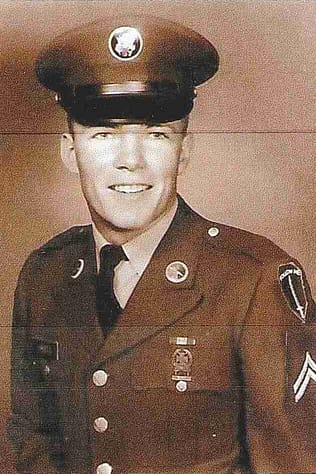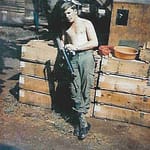One Veteran’s Story – Dale Harbitz
The following is the account of the experiences of one Martin County veteran, Dale Harbitz. “Helicopters were the infantryman’s connection to where we had come from.” Harbitz had many experiences with helicopters and how they were utilized during his tour of duty while being in the infantry. The account of several of his experiences are as follows.
Martin County’s Veterans’ Memorial Site will have a Bell Cobra Rotary Wing Attack Helicopter on display. This helicopter was a stalwart of the U. S. Army’s attack aviation serving in both Vietnam and Laos from 1968-1971, often saving the lives of many American soldiers. There are many Martin County veterans that have experienced helicopter service as well. The following is the account of the experiences of one Martin County veteran, Dale Harbitz.
“Vietnam War, (1954–75), a protracted conflict that pitted the communist government of North Vietnam and its allies in South Vietnam, known as the Viet Cong, against the government of South Vietnam and its principal ally, the United States.”[1]
“The most widely used military helicopter, the Bell UH-1 series Iroquois, better known as the “Huey”, began arriving in Vietnam in 1963. Before the end of the conflict, more than 5,000 of these versatile aircraft were introduced into Southeast Asia. “Hueys” were used for MedEvac, command and control, and air assault; to transport personnel and materiel; and as gunships. Considered to be the most widely used helicopter in the world, with more than 9,000 produced from the 1950s to the present, the Huey is flown today by about 40 countries.”[2]
Vietnam veteran Dale Harbitz, of Sherburn, grew up on a farm east of St. James and graduated from St. James High School in 1967. He attended Worthington Junior College briefly before registering for the draft and enlisting in the Army in July of 1968. Prior to his tour of duty in Vietnam, he spent a total of nine and one-half months in basic training, Advanced Infantry Training, and Non-Commissioned Officer Candidate School.
Harbitz stated his perspective regarding the use and value of helicopters during the Vietnam War:
“Helicopters were the infantryman’s connection to where we had come from. In the “boonies,” we were clearly isolated from anything but the unknown double and triple canopy jungle surrounding us both day and night. Our enemy lie waiting for our incursions, dug-in and seeking to pick us off; the friendly call of our re-supply helicopters bringing in new FNG’s (replacements), c-rations, and water; sometimes, a hot meal. Of the greatest respect for the Medevac choppers, whose crews always answered our call of needful desperation; Gunships, both UH-1 along with Loach and Cobra helicopters often were called upon to provide firepower and aerial support to ground units. These ground units were tasked with the mission of traversing the jungle environs, locating enemy supply routes and positions and in engaging and destroying the enemy! We found the enemy to be well-prepared and willing to take us on, usually at their own timing!”
Harbitz had many experiences with helicopters and how they were utilized during his tour of duty while being in the infantry. The account of several of his experiences are as follows:
On May 11, 1969, Harbitz was on a UH-1 resupply chopper going to join his new unit in the jungle. The pilot decided to give them a “grand entry” into the landing zone by coming in at a high speed, pulling his nose up into a vertical lift, then into a stall, flipping 180 degrees, and finally dropping softly onto the landing zone experiencing what was called a “hammerhead” turn.
On June 17, 1969, a new point man was hit by an NVA sniper smashing the right side of his mouth and jaw. A medevac chopper (UH-1) was called in, but due to the heavy tree canopy was unable to get down to the troops. The medics devised a plan to float the injured soldier out to the middle of the river on an air mattress. Then the Medevac chopper hovered overhead with the skids in the water and floated the injured man onto the deck of the helicopter. The attempt proved successful as a result of the skill demonstrated by the Medevac chopper pilot.
In another instance, in June of 1969, while on patrol west of the north end of Quan Loi basecamp’s airfield they were crossing a lengthy area of dried up rice paddies. They observed six Huey “lift ships” and two Cobra gunships traveling north. Then, one of the Cobras peeled off from the Combat Assault Formation and veered in their direction appearing to come directly at them. The soldiers waved their weapons in the air trying to signal the helicopter that they were not the NVA as it flew directly overhead. The Cobra returned to its original mission while the ground troops were thinking that it could have been what Harbitz described as being a “real bad day.”
In March of 1970 what had started out as a routine flight of a Chinook CH47B twin-rotor helicopter ended tragically. The Chinook moved in at a fast rate of speed with a sling-load full of concertina wire under its belly swaying from side to side. It failed to gain altitude and appeared to have lost hydraulic control to the rotors and turbine control systems. Attempts to regain control of the doomed flight failed and the rear rotor erupted in flames as it fell from the sky tragically ending the lives of its crew of five.
The preceding represents but a few of the many experiences Harbitz encountered while serving in Vietnam. He completed his service in the Army in 1970 returning to Worthington Junior College before transferring to Mankato State University where he earned his BS Degree. Ironically, his experience in Vietnam influenced him in choosing his career as a teacher and administrator as a result of encountering the many innocent children who were the innocent victims of the war that would trade bananas for the soldiers C-Rations.
Harbitz is very appreciative of the Martin County Veterans Memorial Site and the addition of the Cobra helicopter. In addition, he keeps in contact with the men he served with as they have reunions annually.




